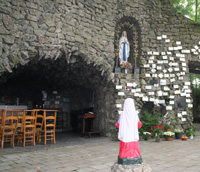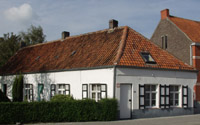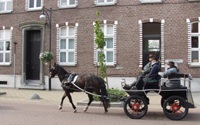The Meetjesland in the north of East-Flanders, Belgium

Kleit, a Meetjesland town
Kleit or, before some of the numerous changes in our spelling, Cleyt, is called after the nature of its substratum: "klei" meaning clay. The parish of 2150 hectares (5310 acres) grew on the border of the Maldegemveld, near the deanery of Papinglo. Maldegemveld was a huge inhospitable swampy region, definitely not the spot a reputable young lady would have chosen for a walk in the moonlight.
The domain of Papinglo is first mentioned in an 1170 document. It was a real abbey built on a hill called Cleythil and it belonged to the Abbey of St. Baafs in Ghent. And all around it there was only a wasteland of heather. This land was then developed little by little just like the Burkel Farm and the Drongen Estate Farm in Ursel. Until the end of the 15th Century Papinglo was a typical religious sttlement with a chapel, monks, sisters and laymen.
 From 1187
until 1537 mass was said for the parishioners in the chapel of the deanery.
In 1476 the chapel was reduced in size. In 1537 there no longer was a priest
and the building deteriorated. The deanery then became an ordinary tenant
farm and that's how it was until the middle of the 18th Century. In 1756 the
farm was built that everyone could admire until 2006. In the 20th Century
the farm was exploited by the Bottelier family. The last two farmer occupants
died in a traffic accident in 1999.
From 1187
until 1537 mass was said for the parishioners in the chapel of the deanery.
In 1476 the chapel was reduced in size. In 1537 there no longer was a priest
and the building deteriorated. The deanery then became an ordinary tenant
farm and that's how it was until the middle of the 18th Century. In 1756 the
farm was built that everyone could admire until 2006. In the 20th Century
the farm was exploited by the Bottelier family. The last two farmer occupants
died in a traffic accident in 1999.
From 1780 the population increased rapidly when Prince de Lobkowitz, the
bishop of Ghent began a new campaign for development. As the number of
faithful increased so did the need for a church and in 1860 a church dedicated
to St. Vincentius à Paulo was opened. The devotion to St. Antonius and to
St. Cornelius, the protector of horned cattle, is visible in the little chapels
around the church. Against the front wall of the church we can admire a
beautiful statue of St. Apollonia by Serafien Goethals from
Adegem.
The inhabitants of Kleit made history as "broom makers". They were welcome on the markets of the whole region with their brooms made from heath or birch twigs. But that of course is long since past.
Kleit still has much of the tower of the old Cuelenaere's Mill in what could be an idyllic setting. The whole property is since 2004 listed as a protected site. But it is heartrending to see the woodwork inside the old mill rotting and the wall crumbling away. I wish a Maecenas could soon be found to help restore it to its former splendour.
 Papinglo Farm on Kleit's highest ground, just next to the road to
Aalter, was built during the last devolpment
period. It still had the date of 1756 in its tiled roof. The house
stands on the foundations of the chapel of the priory that was first mentioned in
documents of 1170. In 1981 the farm was listed as a protected site but it
was unoccupied since the tragic death of the last occupants and its buildings were
slowly but surely going down hill when work started in 2007 to restore the house
to its former glory, to transform the barn into a hotel and the stables into a
restaurant. We gave the restaurant called Kwizien Papinglo a try on
19 June 2008 together with a few (other) connoisseur gastronomes and we were
definitely not disappointed. We liked the interior, the service was very
congenial, the drink was fit for gods, the food was superb, good portions and
absolutely delicious. We were unanimous to say "Highly
recommended ! We'll be back." And we did go back now and
again and again. The first of our half dozen pictures of the risen Papinglo
is here.
Papinglo Farm on Kleit's highest ground, just next to the road to
Aalter, was built during the last devolpment
period. It still had the date of 1756 in its tiled roof. The house
stands on the foundations of the chapel of the priory that was first mentioned in
documents of 1170. In 1981 the farm was listed as a protected site but it
was unoccupied since the tragic death of the last occupants and its buildings were
slowly but surely going down hill when work started in 2007 to restore the house
to its former glory, to transform the barn into a hotel and the stables into a
restaurant. We gave the restaurant called Kwizien Papinglo a try on
19 June 2008 together with a few (other) connoisseur gastronomes and we were
definitely not disappointed. We liked the interior, the service was very
congenial, the drink was fit for gods, the food was superb, good portions and
absolutely delicious. We were unanimous to say "Highly
recommended ! We'll be back." And we did go back now and
again and again. The first of our half dozen pictures of the risen Papinglo
is here.
In 2013 we heard it on the gravevine: Kwizien Papinglo was moving out. The team opened another restaurant in Maldegem called simply Kwizien. Let's hope we'll be able to try it out real soon. And back on the Papinglo farm they held a contest to find a new super-cook. The new team called it simply Papinglo. And let's hope we can go see for ourselves real soon here as well.
 Thanks
to the Reverend Brewée, Kleit's parish priest, a Lourdes
grotto was built in 1950. It is just west of the church in what remains of the
Kluis Woods. It was consecrated in 1952 and almost overnight Kleit became a very
popular place of devotion to the Virgin Mary. This is one of the largest grottos
in Flanders. It was constructed entirely with blocks of concrete that the
parishioners themselves retrieved from the now abandoned airfields that had been built
in the region during WW II. Included in this place of pilgrimage are also a
calvary chapel and a chapel dedicated to St. Rita.
Thanks
to the Reverend Brewée, Kleit's parish priest, a Lourdes
grotto was built in 1950. It is just west of the church in what remains of the
Kluis Woods. It was consecrated in 1952 and almost overnight Kleit became a very
popular place of devotion to the Virgin Mary. This is one of the largest grottos
in Flanders. It was constructed entirely with blocks of concrete that the
parishioners themselves retrieved from the now abandoned airfields that had been built
in the region during WW II. Included in this place of pilgrimage are also a
calvary chapel and a chapel dedicated to St. Rita.
The source of most of the above is the excellent "Streekgids Meetjesland", 1998, pp.45-46. See also: Our Sources.
More pictures from Kleit
Een artikel van rond 1945 over
de Kapel van O. L. Vrouw ten-Doorn
En over
dezelfde kapel gepubliceerd in «Ons Meetjesland» in 1970

More pictures
Our Meetjesland
— Table of Contents
— Find something in this Meetjesland website

MijnPlatteLand.com
Most recent update : 24-07-2021
Copyright Notice (c) 2024

